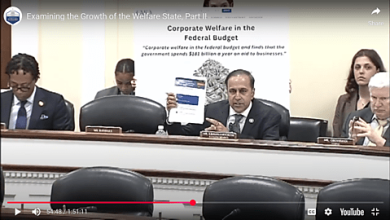Harris’s Tax on Unrealized Gains is Only the Tip of a $5 Trillion Tax Iceberg

Vice President Kamala Harris’s campaign recently confirmed that she supports all the nearly $5 trillion in tax increases included in President Biden’s 2025 budget proposal. Among the long list of tax hikes is a novel proposal to tax the unrealized gains of wealthy Americans. As many commentators have noted, such a tax would be economically destructive, but the fervor over this one bad idea has distracted from other more wide-reaching and even more economically damaging proposals.
For example, Harris’s 28 percent federal corporate tax rate and 44.6 percent top capital gains and dividend tax rate would give the United States the highest total tax rate on corporate income in the developed world when combined with state taxes. As I recently explained, workers ultimately bear most of the cost of the corporate income tax through lower wages and fewer job opportunities. Because the corporate income tax is one of the most economically destructive ways to raise revenue, the total economic cost of Harris’ proposed tax hike will likely be multiple times larger than the tax revenue it raises.
The Harris plan would also increase top federal income tax rates so that combined state, local, and federal tax rates would be on the wrong side of the Laffer curve in 36 states and Washington, DC—the point at which higher tax rates create so much economic distortion that they no longer bring in additional tax revenue.
The cumulative economic losses from Harris’s tax hikes will be death from a thousand cuts. Each proposal may seem targeted at just a few Americans, a particular industry, or only profitable companies. However, taken together, Harris proposes the largest tax increase in more than 40 years, raising tax rates to some of the highest in the world and resulting in lower wages for American workers and slower economic growth.
Some of the other more than 90 proposals include a higher stock buyback tax, new global minimum taxes, higher taxes on carried interest, new limits on the deductibility of wages for highly paid employees, elimination of some like-kind exchanges, permanent loss limitations for pass-through businesses, higher taxes on oil, gas, and coal production, limits on retirement contributions and accelerated minimum distributions for some high‐income individuals, a new 30 percent excise tax on digital mining electricity costs, and a higher death tax.
One of the more narrowly tailored new taxes that deserves some additional analysis is a novel proposal to tax unrealized capital gains.
Taxing Unrealized Gains
The Harris plan includes a new minimum tax of 25 percent on traditional income and unrealized capital gains for taxpayers with more than $100 million in total wealth. While ostensibly limited by a high net-worth threshold, such a tax would be economically destructive and administratively unworkable—not to mention unconstitutional.
What’s wrong with taxing unrealized gains? The core problem with taxing unrealized gains is that there is not actually anything to tax until the asset is sold for a profit. For example, if I purchase a house for $400,000 and it appreciates by $50,000 the following year—an unrealized gains tax at 25 percent would mean I owe the government $12,500, regardless of whether I sell the house or have the cash on hand to pay the bill.
If you don’t have the cash, such a system would force you to sell your home or take out a loan to pay the government. Levying a tax on someone’s projected future income before they have full claim to it themselves also raises deeper questions about individual property rights, financial privacy, and due process.
The pursuit of taxes on unrealized gains turns on a core disagreement about what constitutes “income.” Cato’s Chris Edwards recently noted, “Unrealized capital gains are not a component of any of 11 different measures of income currently used by various federal agencies, and unrealized gains have been excluded from income since the first modern income tax law of 1913.” However, some liberal tax scholars have long sought to define income as an individual’s annual change in net worth—a measure that includes wages plus any increase or decrease in the value of assets. Thus, an unrealized capital gains tax, often also called a mark-to-market tax, uses a better approximation of these liberal economist’s preferred tax base, which is biased against saving and investment.
Taxing unrealized gains raises effective tax rates on US savers by making them pre-pay their taxes on gains not yet realized. An unrealized gains tax paid annually out of cash on hand increases taxes paid by more than 12 percent.[1] Such a tax increase on investment returns would disincentivize entrepreneurship, new business start-ups, angel investing, and overall investment in leading-edge industries. The new tax would also disadvantage domestic investors relative to similarly situated foreign investors not subject to the tax.
Few other countries tax unrealized market gains in the way Harris proposes because it is administratively unworkable. One of the practical challenges is appropriately accounting for losses when the value of an asset declines. If paper gains are taxed, paper losses require a rebate for pre-paid taxes. In 2022, when Elon Musk’s net worth declined by a record-breaking $182 billion, the government would have owed him a $45 billion check—in effect, paying him back some of the taxes he paid in previous years on gains that were only fleeting. Writing the wealthiest Americans large checks when the economy falters would create significant budgetary issues, not to mention difficult political perceptions.
Acknowledging some of these administrative difficulties, the brief description of the Harris proposal includes rules that formulaically value non-tradeable assets, a separate system of rules for illiquid taxpayers, and refund rules for some overpayments. Even with simplified rules, taxes based on asset values are all but impossible to administer and would place extraordinary new burdens on an already poorly performing IRS. It took 12 years for the IRS and the estate of Michael Jackson to reach a court-mediated agreement on the value of the estate’s assets. Going through such a process every year for all taxpayers with assets near the tax threshold is administratively impracticable.
Some commenters have brushed off concerns about the tax because it would not apply to most people (by one estimate, there are about 10,660 centi-millionaires in the US). Unfortunately, exempting most people from a burdensome tax does not make it any better policy. And arbitrary thresholds should not provide much comfort to the majority of Americans who would still be exempt from the income tax had the 1916 exemption threshold continued to protect 99 percent of Americans from the tax. Senate Finance Chairman Ron Wyden has a similarly flawed unrealized gains tax proposal with a threshold ten times lower than Harris’s ($10 million in assets or $1 million in income).
Conclusion
Harris’s proposal to tax unrealized gains may appear to target only the wealthiest Americans, but it sets a dangerous precedent that would pave the way for even more aggressive and economically damaging tax increases. This tax is not just an attack on the wealthy; it’s an assault on investment, innovation, and economic growth, risking widespread economic damage that will be felt across the entire economy. And it is just the tip of the iceberg—it’s one of more than 90 proposed tax increases and other changes that target the engine of American prosperity.
[1] Assumes a 7% annual return for 10 years. Expressed in present value assuming 3 percent inflation.





